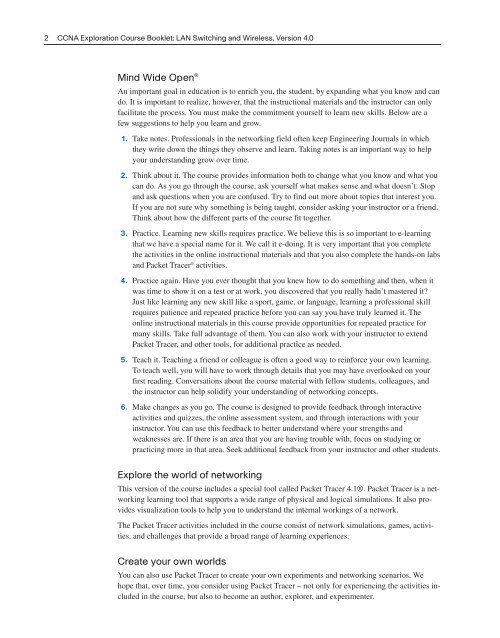CCNA Exploration LAN Switching and Wireless
CCNA Exploration LAN Switching and Wireless
CCNA Exploration LAN Switching and Wireless
Create successful ePaper yourself
Turn your PDF publications into a flip-book with our unique Google optimized e-Paper software.
2 <strong>CCNA</strong> <strong>Exploration</strong> Course Booklet: <strong>LAN</strong> <strong>Switching</strong> <strong>and</strong> <strong>Wireless</strong>, Version 4.0<br />
Mind Wide Open ®<br />
An important goal in education is to enrich you, the student, by exp<strong>and</strong>ing what you know <strong>and</strong> can<br />
do. It is important to realize, however, that the instructional materials <strong>and</strong> the instructor can only<br />
facilitate the process. You must make the commitment yourself to learn new skills. Below are a<br />
few suggestions to help you learn <strong>and</strong> grow.<br />
1. Take notes. Professionals in the networking field often keep Engineering Journals in which<br />
they write down the things they observe <strong>and</strong> learn. Taking notes is an important way to help<br />
your underst<strong>and</strong>ing grow over time.<br />
2. Think about it. The course provides information both to change what you know <strong>and</strong> what you<br />
can do. As you go through the course, ask yourself what makes sense <strong>and</strong> what doesn’t. Stop<br />
<strong>and</strong> ask questions when you are confused. Try to find out more about topics that interest you.<br />
If you are not sure why something is being taught, consider asking your instructor or a friend.<br />
Think about how the different parts of the course fit together.<br />
3. Practice. Learning new skills requires practice. We believe this is so important to e-learning<br />
that we have a special name for it. We call it e-doing. It is very important that you complete<br />
the activities in the online instructional materials <strong>and</strong> that you also complete the h<strong>and</strong>s-on labs<br />
<strong>and</strong> Packet Tracer ® activities.<br />
4. Practice again. Have you ever thought that you knew how to do something <strong>and</strong> then, when it<br />
was time to show it on a test or at work, you discovered that you really hadn’t mastered it?<br />
Just like learning any new skill like a sport, game, or language, learning a professional skill<br />
requires patience <strong>and</strong> repeated practice before you can say you have truly learned it. The<br />
online instructional materials in this course provide opportunities for repeated practice for<br />
many skills. Take full advantage of them. You can also work with your instructor to extend<br />
Packet Tracer, <strong>and</strong> other tools, for additional practice as needed.<br />
5. Teach it. Teaching a friend or colleague is often a good way to reinforce your own learning.<br />
To teach well, you will have to work through details that you may have overlooked on your<br />
first reading. Conversations about the course material with fellow students, colleagues, <strong>and</strong><br />
the instructor can help solidify your underst<strong>and</strong>ing of networking concepts.<br />
6. Make changes as you go. The course is designed to provide feedback through interactive<br />
activities <strong>and</strong> quizzes, the online assessment system, <strong>and</strong> through interactions with your<br />
instructor. You can use this feedback to better underst<strong>and</strong> where your strengths <strong>and</strong><br />
weaknesses are. If there is an area that you are having trouble with, focus on studying or<br />
practicing more in that area. Seek additional feedback from your instructor <strong>and</strong> other students.<br />
Explore the world of networking<br />
This version of the course includes a special tool called Packet Tracer 4.1®. Packet Tracer is a networking<br />
learning tool that supports a wide range of physical <strong>and</strong> logical simulations. It also provides<br />
visualization tools to help you to underst<strong>and</strong> the internal workings of a network.<br />
The Packet Tracer activities included in the course consist of network simulations, games, activities,<br />
<strong>and</strong> challenges that provide a broad range of learning experiences.<br />
Create your own worlds<br />
You can also use Packet Tracer to create your own experiments <strong>and</strong> networking scenarios. We<br />
hope that, over time, you consider using Packet Tracer – not only for experiencing the activities included<br />
in the course, but also to become an author, explorer, <strong>and</strong> experimenter.

















